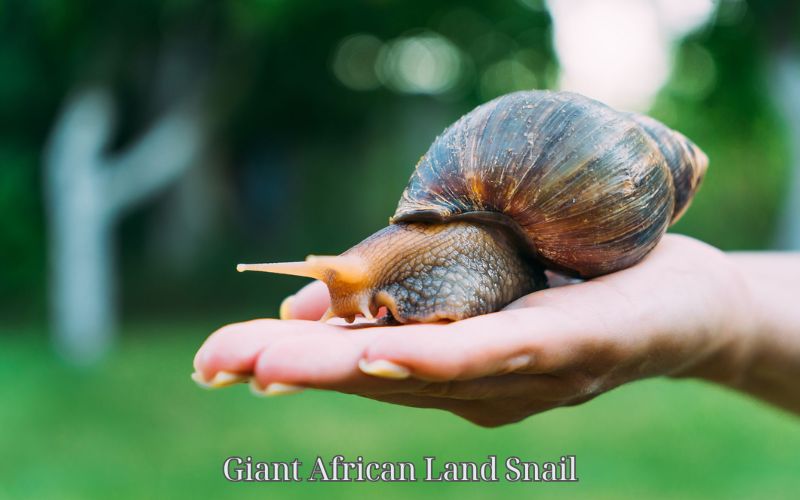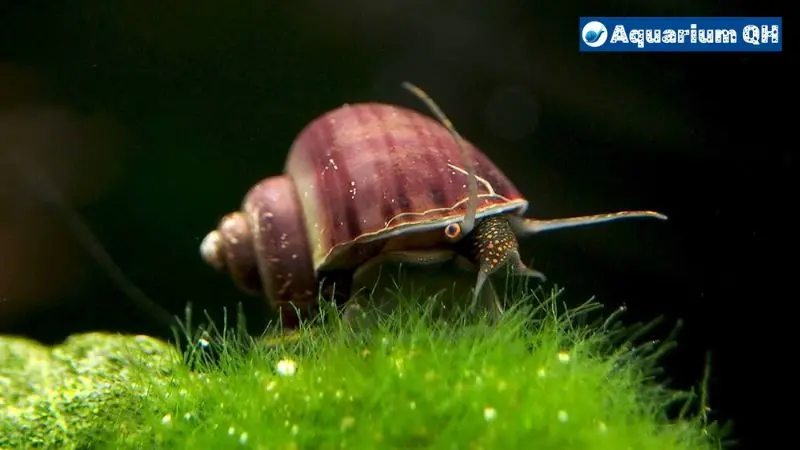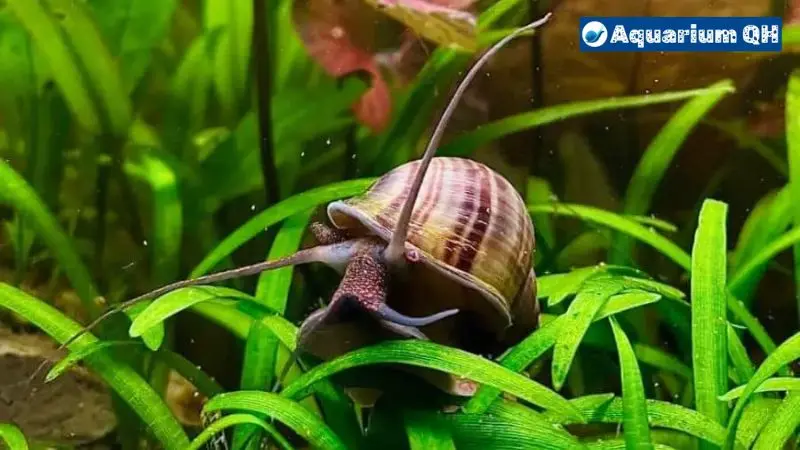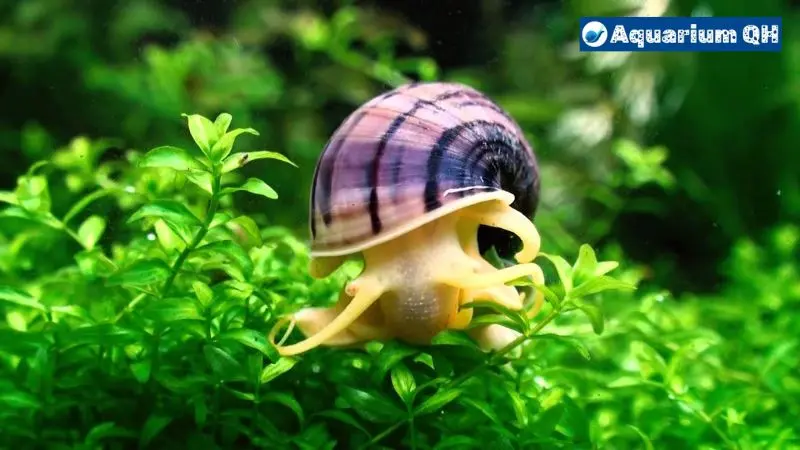The Giant African Land Snail (GALS) is a fascinating creature known for its immense size, unique appearance, and adaptability. Native to Africa, this mollusk has become a popular pet, agricultural concern, and even a source of natural remedies in some cultures. In this article, Aquariumqh.com will explore everything you need to know about Giant African Land Snails, including their habitat, care, uses, and the controversies surrounding them.
1. What Are Giant African Land Snails?
The Giant African Land Snail, scientifically known as Achatina achatina or Achatina fulica, is one of the largest terrestrial snails in the world. Some individuals can grow up to 20 cm in length and weigh over 1 kilogram.
1.1. Physical Features
- Shell: The shell of a Giant African Land Snail is conical and spiraled, often exhibiting shades of brown with striking patterns.
- Body: The soft body is grayish-brown and highly flexible, allowing the snail to retract completely into its shell for protection.
- Size: They are significantly larger than common garden snails, making them a standout species.
1.2. Native Habitat
These snails are native to the warm and humid regions of sub-Saharan Africa. They thrive in tropical climates, where they can find abundant food sources like fruits, vegetables, and organic matter.
2. Why Are Giant African Land Snails Popular Pets?
Owning a Giant African Land Snail has become a trend for exotic pet enthusiasts. But what makes them so appealing?
2.1. Low Maintenance
GALS are easy to care for, requiring minimal effort compared to other pets. They need a simple habitat, regular feeding, and occasional cleaning.
2.2. Educational Value
These snails are often kept in classrooms or homes to teach children about biology, ecosystems, and the responsibilities of pet care.
2.3. Hypoallergenic
Unlike furry pets, snails do not trigger allergies, making them suitable for individuals with sensitivities.
2.4. Longevity
With proper care, a Giant African Land Snail can live up to 10 years, offering a long-term commitment for pet owners.
3. How to Care for Giant African Land Snails
If you’re considering keeping a Giant African Land Snail as a pet, here’s how to ensure they thrive:
3.1. Setting Up the Habitat
- Enclosure: Use a spacious plastic or glass tank with a secure lid to prevent escapes.
- Substrate: Provide a soft substrate such as coconut coir, soil, or moss to help retain moisture.
- Temperature and Humidity: Maintain a temperature between 20°C and 30°C with high humidity (70-90%).
- Hiding Spots: Include logs, rocks, or plants for the snail to retreat and hide.
3.2. Diet and Feeding
GALS are herbivores and require a varied diet:
- Staple Foods: Leafy greens, cucumbers, carrots, and apples.
- Calcium: Provide a calcium source like cuttlebone or powdered eggshells to strengthen their shells.
- Avoid: Salty, spicy, or processed foods that can harm the snail.
3.3. Cleaning and Maintenance
Regularly clean the enclosure to remove waste and leftover food, ensuring a hygienic environment.
3.4. Health and Wellbeing
Check for cracks in the shell or unusual behavior, as these may indicate health issues. Keep an eye out for pests like mites that can infest the enclosure.
4. Environmental Concerns of Giant African Land Snails
While they are fascinating pets, GALS pose significant environmental risks when introduced to non-native habitats.
4.1. Agricultural Pests
Giant African Land Snails are voracious eaters and can decimate crops. In countries like the United States, they are considered invasive species that threaten agriculture and ecosystems.
4.2. Rapid Reproduction
A single snail can lay up to 1,200 eggs annually, leading to rapid population growth if not controlled.
4.3. Disease Transmission
These snails can carry parasites like the rat lungworm (Angiostrongylus cantonensis), which can cause meningitis in humans if consumed or handled improperly.
5. Benefits of Giant African Land Snails
Despite their controversies, Giant African Land Snails offer several benefits.
5.1. Natural Remedies
In traditional African medicine, snail mucin is used for wound healing and skin care due to its moisturizing and regenerative properties.
5.2. Research and Education
GALS are valuable for scientific research in areas like mollusk behavior, reproduction, and environmental adaptation.
5.3. Sustainable Food Source
In some cultures, these snails are considered a delicacy and a sustainable protein source.
6. Legal Considerations for Owning Giant African Land Snails
Before acquiring a Giant African Land Snail, check local regulations. In many countries, owning or importing these snails is restricted or banned due to their invasive potential.
6.1. Countries Where GALS Are Banned
- United States: Classified as a quarantine pest by the USDA.
- Australia: Strict biosecurity laws prohibit their ownership.
6.2. Licensing and Permits
In regions where they are allowed, you may need a permit to keep them legally.
7. Interesting Facts About Giant African Land Snails
- Largest Recorded Specimen: The largest Giant African Land Snail on record measured over 39 cm in length.
- Self-Sufficient Reproduction: GALS are hermaphrodites, meaning each snail has both male and female reproductive organs.
- No Teeth: They have a radula, a ribbon-like structure with thousands of tiny tooth-like structures for grinding food.
- Nocturnal Creatures: These snails are most active at night.
8. Should You Keep a Giant African Land Snail?
8.1. Pros
- Low maintenance.
- Educational and unique.
- Long lifespan.
8.2. Cons
- Potential environmental hazards if released.
- Risk of disease transmission.
- Legal restrictions in certain areas.
If you’re committed to providing a suitable environment and abiding by local laws, a Giant African Land Snail can be a rewarding and fascinating pet.
Conclusion
The Giant African Land Snail is a remarkable species with a mix of benefits and challenges. Whether kept as a pet, used in research, or consumed as food, these snails leave an indelible mark on the ecosystems and cultures they encounter. However, their invasive nature and potential health risks require responsible ownership and strict regulation.
If you’re captivated by these gentle giants, make sure to do thorough research and provide a safe, legal, and sustainable environment. Remember, the question isn’t just about their size or benefits, but how we can coexist responsibly with such an extraordinary creature.




